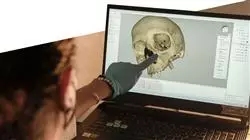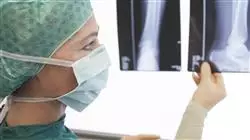University certificate
The world's largest faculty of nursing”
Description
You will gain a deep understanding of the structure of the human skeleton and biological identification through this Postgraduate Diploma, based on a 100% online methodology"

The emergence of the so-called Industry 4.0 has considerably impacted the Forensic Radiology sector, driving the development of more advanced healthcare imaging technologies. An example of this is Magnetic Resonance Imaging, which provides high-resolution images that allow detailed visualization of internal structures of the human body (such as soft tissues). This tool also detects lesions as well as anomalies or pathologies that are relevant for the recognition of individuals. For example, the presence of a metallic prosthesis. In this way, professionals obtain valuable information that contributes significantly to establish the identity of the deceased.
Faced with this reality, TECH implements a Postgraduate diploma in Forensic Radiology in Human Identification. Aimed at nursing personnel, the main objective of this program is that these professionals keep themselves technologically updated and master the basic principles to identify injuries in the body of individuals. Therefore, the syllabus will deal with the particularities of the human skeleton, as well as biological identification. In this sense, the specialization will provide the keys to the operation of innovative tools, among which Computed Tomography, Virtopsias or X-Rayox Tubes stand out. Likewise, the didactic materials will offer a detailed classification of traumatic fractures in the forensic context that will enable graduates to detect possible cases of child abuse and even illegal drug transportation.
Regarding the learning system, this course is taught completely online, providing professionals with the necessary flexibility to adapt to their schedules. Additionally, the Relearningmethodology, based on the repetition of key concepts to fix the knowledge, will facilitate effective and long-lasting learning. This combination of accessibility and innovative pedagogical approach will ensure that graduates will acquire practical skills to optimize both their clinical work and clinical care.
450 hours of intensive study that will lay the foundation for your professional growth and take you to the pinnacle of Nursing"
This Postgraduate diploma in Forensic Radiology in Human Identification contains the most complete and up-to-date scientific program on the market. The most important features include:
- The development of practical cases presented by experts in Forensic Radiology
- The graphic, schematic and eminently practical contents with which it is conceived gather scientific and practical information on those disciplines that are indispensable for professional practice
- Practical exercises where the self-assessment process can be carried out to improve learning
- Its special emphasis on innovative methodologies
- Theoretical lessons, questions to the expert, debate forums on controversial topics, and individual reflection assignments
- Content that is accessible from any fixed or portable device with an Internet connection
You will delve into the Stages of Bone Repair to determine the time elapsed since the occurrence of an injury and contribute to establishing the chronology of events"
The program’s teaching staff includes professionals from the field who contribute their work experience to this educational program, as well as renowned specialists from leading societies and prestigious universities.
The multimedia content, developed with the latest educational technology, will provide the professional with situated and contextual learning, i.e., a simulated environment that will provide immersive education programmed to learn in real situations.
This program is designed around Problem-Based Learning, whereby the professional must try to solve the different professional practice situations that arise during the course. For this purpose, students will be assisted by an innovative interactive video system created by renowned and experienced experts.
Are you looking to enrich your practice with the most innovative techniques for post mortem evaluations? This university program will address in detail the Virtopsia, the latest trend in this area"

Thanks to TECH's Relearning system, you will assimilate the essential concepts in a fast, natural and precise way"
Syllabus
Through this Postgraduate diploma, graduates will obtain a holistic vision of Forensic Radiology in Human Identification. To this end, the academic itinerary will focus on the exhaustive analysis of the human skeleton and biological identification. In this way, professionals will be highly qualified to estimate the age, height and muscular complexion of individuals. Likewise, the syllabus will deal with the main pathologies related to Forensic Investigation, through state-of-the-art techniques such as Ultrasound. This will contribute to the identification of internal injuries, anatomical anomalies or diseases that may have contributed to the death of the subjects.

You will have access to the most complete and updated syllabus in the academic market, which will allow you to make substantial progress in your career as a Nurse"
Module 1. Forensic Radiology in Human Identification
1.1. Human Identification in the Forensic Context
1.1.1. In Police Cases
1.1.2. In Judicial Cases
1.1.3. In Crimes Against Humanity and War Crimes
1.1.4. In Major Disasters
1.2. The Human Skeleton and Biological Identification (I): Osteological Sexual Characterization in Adults
1.2.1. Sexual Characterization Through the Skull
1.2.2. Sexual Characterization Through the Hip
1.2.3. Osteological Sex Characterization from Other Bones
1.3. The Human Skeleton and Biological Identification (II): Osteological Sexual Characterization in Individuals in Maturing Stages.
1.3.1. Sexual Characterization Through the Skull
1.3.2. Sexual Characterization Through the Hip
1.3.3. Osteological Sex Characterization from Other Bones
1.4. The Human Skeleton and Biological Identification (III): Determination of Age at Death in Adult Individuals
1.4.1. Age Determination from the Closure of Bone Epiphyses and Cranial Sutures
1.4.2. Age Determination from Cartilage Ossification
1.4.3. Age Determination from the Modification of Bone Regions
1.5. The Human Skeleton and Biological Identification (IV): Age Determination at Death in Maturing Individuals
1.5.1. Determination of age from Morphometrics
1.5.2. Age Determination by Bone Birth
1.5.3. Age Determination by Epiphyseal and Fontanel Closure
1.6. The Human Skeleton and Biological Identification (V): Determination of Stature and Muscular Build
1.6.1. Estimation of Stature of Anatomical Nature
1.6.2. Estimation of Stature of Physiological Nature
1.6.3. Bone Biomechanics and Adaptation to Physical Activity
1.6.4. Development of Muscular Complexion
1.7. Human Dentition for the Calculation of Age at Death
1.7.1. The Dentition in Maturing Individuals
1.7.2. Dentition in Adult Individuals
1.7.3. Dental Alterations and Pathologies
1.8. Biomechanics and Mechanical Forces Applied to Bone Trauma
1.8.1. Osteological Growth and Development
1.8.2. Mechanical Forces Applied to the Human Skeleton
1.8.3. Bone Adaptation to Exercise
1.9. Bone Trauma due to Temporality
1.9.1. Characterization of AntemortemTraumas
1.9.2. Characterization of PerimortemTraumas
1.9.3. Characterization of PostmortemTrauma
1.10. Trauma by Type of Injury
1.10.1. Classification by Type of Injury
1.10.2. Classification by Type of Weapon
1.10.3. Classification by Type of Object and Structure
Module 2. Radiodiagnosis of Pathologies Related to Forensic Investigation
2.1. Classification of Traumatic Fractures in the Forensic Context
2.1.1. Classification According to Skin Condition
2.1.2. Classification According to Location
2.1.3. Classification According to Fracture Trace
2.2. Stages of Bone Repair in the Forensic Context
2.2.1. Inflammatory Phase
2.2.2. Repair Phase
2.2.3. Remodeling Phase
2.3. Child Maltreatment and its Radiodiagnosis in a Forensic Context
2.3.1. Simple Radiography
2.3.2. Axial Tomography
2.3.3. Magnetic Resonance
2.4. Illegal Transport of Narcotics and Radiodiagnostics in a Forensic Context
2.4.1. Simple Radiography
2.4.2. Axial Tomography
2.4.3. Magnetic Resonance
2.5. Simple Radiographic Technique for Identification of Alterations within a Forensic Context
2.5.1. Cranial Pathologies
2.5.2. Thoracic Pathologies
2.5.3. Extremity Pathologies
2.6. Ultrasound Technique for Identification of Pathologies within a Forensic Context
2.6.1. Ultrasound
2.6.2. Obstetric
2.6.3. Wall
2.7. Computed Tomography and Identification of Pathologies in a Forensic Context
2.7.1. Cranial
2.7.2. Wall
2.7.3. Ultrasound
2.8. Magnetic Resonance Imaging and Pathology Identification in a Forensic Context
2.8.1. Cranial
2.8.2. Wall
2.8.3. Ultrasound
2.9. Diagnostic Angiography in a Forensic Context
2.9.1. Cranial
2.9.2. Ultrasound
2.9.3. Extremities
2.10. Virtopsia, Radiology in Forensic Medicine
2.10.1. Resonance
2.10.2. Tomography
2.10.3. Radiography
Module 3. Forensic Radiodiagnosis of Maxillofacial Trauma
3.1. Forensic Maxillofacial Trauma: Fractures of the Upper Third of the Face
3.1.1. Fractures of the Frontal Bone
3.1.2. Fractures of the Walls of the Frontal Sinuses
3.1.3. Fractures of the Temporal/Parietal Bone
3.2. Forensic Maxillofacial Trauma: Fractures of the Middle Third of the Face
3.2.1. Nasal Fractures
3.2.2. Orbital Fractures
3.2.3. Fractures of the Naso-Orbito-Ethmoidal Complex
3.2.4. Fractures of the Zygomatic Bone
3.3. Forensic Maxillofacial Trauma: Fractures of the Lower Third of the Face.
3.3.1. Fracture of the Mandibular Symphysis / Parasymphysis
3.3.2. Fracture of the Mandibular Body
3.3.3. Mandibular Angle Fracture
3.3.4. Mandibular Ramus Fracture
3.3.5. Fracture of the Mandibular Condyle
3.4. Forensic Maxillofacial Trauma: Le Fort Fractures
3.4.1. Le Fort I Fractures
3.4.2. Le Fort II Fractures
3.4.3. Le Fort III Fractures
3.4.4. Le Fort IV Fractures
3.5. Forensic Maxillofacial Trauma: Alveolodental Fractures
3.5.1. Coronary Fracture
3.5.2. Corono-Radicular Fracture
3.5.3. Root Fracture
3.5.4. Alveolar Fracture
3.5.5. Avulsion
3.6. Radiographic Techniques for the Study of Maxillofacial Trauma in the Forensic Context.
3.6.1. X-Ray
3.6.2. Computerized Axial Tomography
3.6.3. Other Radiographic Techniques
3.7. Radiographic Techniques for the Study of Alveolar Tooth Trauma in the Forensic Context
3.7.1. X-Ray
3.7.2. Computerized Axial Tomography
3.7.3. Other Radiological Techniques
3.8. Radiographic Interpretation of Maxillofacial Trauma in the Forensic Context: Isolated Fractures.
3.8.1. Radiographic Interpretation of Trauma to the Upper Third of the Face.
3.8.2. Radiographic Interpretation of Trauma of the Middle Third of the Face
3.8.3. Radiographic Interpretation of Trauma of the Lower Third of the Face
3.9. Radiographic Interpretation of Maxillofacial Trauma Within the Forensic Context Le Fort Fractures
3.9.1. Radiographic Interpretation in Le Fort I Fractures
3.9.2. Radiographic Interpretation in Le Fort II Fractures
3.9.3. Radiographic Interpretation in Le Fort III Fractures
3.9.4. Radiographic Interpretation in Le Fort IV Fractures
3.10. Radiographic Techniques for the Study of Alveolar Tooth Trauma in the Forensic Context
3.10.1. Coronary Fracture
3.10.2. Corono-Radicular Fracture
3.10.3. Alveolar Fracture
3.10.4. Root Fracture
3.10.5. Avulsion

A high quality university program that will give you the flexibility to combine it with your most demanding daily responsibilities. Enroll now!”
Postgraduate Diploma in Forensic Radiology in Human Identification
Descubre en TECH Global University una oportunidad excepcional para adentrarte en el fascinante campo de la radiología forense con nuestro posgrado de Experto Universitario en Radiología Forense en la Identificación Humana, diseñado específicamente para profesionales de enfermería que buscan ampliar sus conocimientos y habilidades en este campo especializado y de vital importancia en la ciencia forense. Nuestro programa se distingue por ofrecer una combinación única de rigor académico, flexibilidad y conveniencia a través de clases 100% online. Esta modalidad te permite acceder a la educación de alta calidad desde cualquier lugar del mundo y en cualquier momento que se ajuste a tu agenda, permitiéndote avanzar en tus estudios sin comprometer tus responsabilidades laborales y personales. En nuestro programa, te sumergirás en el estudio de técnicas avanzadas de imagenología, análisis radiográfico y peritaje forense, desarrollando habilidades especializadas que te permitirán identificar y evaluar de manera precisa y detallada los restos humanos en contextos forenses.
Join the best online university and get a qualification in Forensic Radiology
The teaching staff of this program is composed of expert and recognized professionals in the field of forensic radiology, who will provide you with a state-of-the-art qualification and guide you on your way to mastery of this specialized discipline. Through masterclasses, real case studies and supervised practice, you will gain an in-depth understanding of the fundamental principles and techniques of forensic radiology in human identification. Upon successful completion of our postgraduate program, you will be prepared to face real-world challenges in the forensic field. You will be able to contribute significantly to the identification and resolution of cases, working collaboratively with multidisciplinary teams in hospitals, forensic laboratories, law enforcement agencies and other justice and public safety related institutions. Boost your career and make a difference in the field of forensic nursing with the expertise and support of TECH Global University. Enroll today and take the first step toward a successful and rewarding career in forensic radiology!







